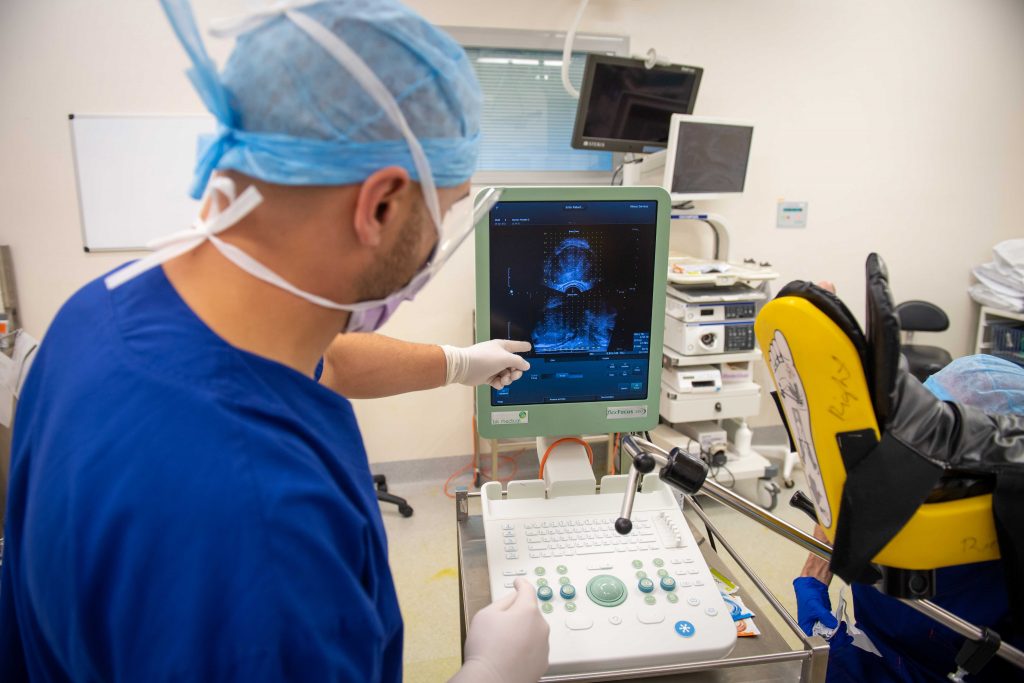Prostate enlargement is also sometimes referred to as BPH, or benign prostatic hyperplasia. It is a common condition that affects aging men.
Prostate enlargement is also sometimes referred to as BPH, or benign prostatic hyperplasia. It is a common condition that affects aging men. With increasing age, the prostate gland can undergo non-cancerous growth. This can cause troublesome urinary symptoms for some men.
If you have been diagnosed with BPH, you might be wondering what prostate enlargement treatment options are available. In this blog, we will cover some of the available options, however the best source of information is always your urologist, who will be able to advise you which treatments are the most appropriate for your condition.

Prostate enlargement treatment options– What is the prostate gland?
Before we can look at prostate enlargement treatment options, it is important to understand what the prostate gland is and where it is located. The prostate is located just below the bladder, in front of the rectum. It is about the size of a walnut and forms part of the urethra (the tube through which urine flows out of the body). The prostate produces part of the fluid that makes up semen.
In some men, when the prostate becomes enlarged, the tissue becomes obstructive and causes bothersome urinary symptoms. These symptoms can include difficulty starting/stopping urination, slow or dribbly flow, increased frequency and urgency to urinate, and frequent waking in the night to urinate (nocturia).
Thankfully, there are a number of effective prostate enlargement treatment options available.
Prostate enlargement treatment options– Medical treatments
Medical therapy is often one of the first prostate enlargement treatment options that men opt for. Medical therapy means the use of pharmaceutical medications including alpha-blockers and 5-alpha reductase inhibitors. These are the two main classes of drugs used in the treatment of prostate enlargement.
Alpha-blockers: This class of drugs works by relaxing the muscles in the prostate and bladder neck. This allows urine to flow more freely, thereby reducing the symptoms caused by the enlarged prostate gland. Some commonly prescribed types of alpha-blockers include tamsulosin, silodosin and prazosin.
5-alpha reductase inhibitors: These medications work by blocking the conversion of the hormone testosterone to dihydrotestosterone (DHT). DHT is known to contribute to the growth of the prostate. Finasteride and dutasteride are two examples of 5-alpha reductase inhibitors that may be prescribed.
For some men, combination therapy using medications that contain both alpha-blockers and 5-alpha reductase inhibitors is the most effective prostate enlargement treatment, in terms of medical options.
Prostate enlargement treatment options– Minimally invasive procedures
Minimally invasive procedures are another option for prostate enlargement treatment. Men may choose this option when medication does not provide them with adequate relief from their symptoms, or perhaps they do not wish to take medication in the long term (possibly due to side effects, cost, or other reasons). Additionally, minimally invasive procedures may be appropriate to consider in circumstances where the patient’s symptoms worsen.
Some of the common minimally invasive prostate enlargement treatment options include:
TURP (transurethral resection of the prostate): The patient is placed under anaesthesia, and a special instrument known as a resectoscope is inserted through the urethra. The obstructing prostate tissue is then removed. The TURP procedure can provide significant relief from symptoms for men with BPH.
Rezum therapy: this prostate enlargement treatment uses thermal energy (steam) from water vapour to ablate excessive prostate tissue, which causes it to shrink. The procedure is performed under anaesthetic. Most patients find significant improvement in their urinary symptoms following Rezum therapy. In the majority of patients, sexual function is preserved.
Other minimally invasive prostate enlargement treatments: There are some other options for minimally invasive treatments for BPH as well. These include therapies such as laser (HoLEP or greenlight) and Urolift. You can speak to your urologist about these treatment options, or find more information under the ‘Procedures’ tab on our website.
Prostate enlargement treatment options– robotic enucleation of the prostate
Robotic enucleation of the prostate is a treatment that may be offered in instances where the prostate is too large for TURP, laser or minimally invasive procedures.
Robotic-assisted enucleation of the prostate replicates the traditional open surgery, but instead uses the Da Vinci Robotic Surgical System to assist the surgeon, facilitating the use of very small robotic instruments to remove the obstructive tissue as a keyhole procedure.
Prostate enlargement treatment options to discuss with your urologist
Once a diagnosis of BPH has been made, you’ll want to know what your prostate enlargement treatment options are. BPH can have a profound impact on a man’s quality of life, so speaking to your doctor about early diagnosis and prompt treatment is essential in order to effectively manage the condition.
Fortunately, there are a number of different types of prostate enlargement treatment options available, ranging from medical therapies, through to minimally invasive procedures and robotic surgery.
If you are experiencing urinary symptoms, speak to your GP or consult a urologist for an accurate diagnosis. If you are diagnosed with BPH, your urologist will be able to recommend the treatments that will be most effective for your individual condition.
At Melbourne Urology Centre, our urological surgeons are highly experienced in prostate enlargement treatment. With our specialised care, men suffering from urinary symptoms can find prompt and effective relief, and lead a more comfortable life.
